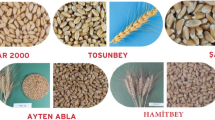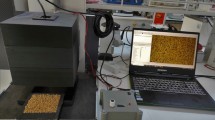Abstract
Wheat is unquestionably the primary source of sustenance in human dietary intake. The cultivation areas and production capacity of wheat worldwide have been observed to increase in parallel with the growth of the global population. Wheat grains from different varieties, when mixed with durum wheat, result in a reduction in the protein content. Various types of wheat grains also exhibit the same characteristic. In this particular scenario, the significance of accurately categorizing wheat becomes more pronounced. In recent years, there has been a proliferation of studies aimed at categorizing agricultural products through the application of deep learning and machine learning methodologies. In the present study, a novel approach was introduced to simultaneously analyze deep features and image patches. This was achieved by utilizing a dataset consisting of a comprehensive collection of 8354 images, encompassing various bread wheat varieties. The classification of wheat types was carried out by employing feature extraction using three distinct methods. MobileNetV2, EfficientNetV2B0, GLCM, and Color-Space algorithms were employed to extract features from the images. Lastly, the Support Vector Machine (SVM), Random Subspace ensemble with k-Nearest Neighbors (RSeslibKnn), Artificial Neural Network (ANN), and Random Forest algorithms were employed to develop models for the classification of bread wheat images. The evaluation of the experimental performances was conducted based on the criteria of accuracy, precision, recall, F-score, and mean absolute error (MAE). In general, the obtained accuracies ranged from 91.50 to 98.65%, which demonstrates the models’ proficiency in accurately classifying the samples. When examining different algorithms, Support Vector Machines (SVM) consistently demonstrate robust performance by achieving high levels of accuracy, precision, recall, and F-scores across various feature combinations.






Similar content being viewed by others
Data availability
Data can be found in this link (https://www.aliyasar.com/datasets/).
References
Yasar A (2023) Benchmarking analysis of CNN models for bread wheat varieties. Eur Food Res Technol 249(3):749–758
Golcuk A, Yasar A (2023) Classification of bread wheat genotypes by machine learning algorithms. J Food Compos Anal 119:105253
Kutlu I, Karaduman Y, Gulmezoglu MB (2021) Classifying wheat genotypes using machine learning models for single kernel characterization system measurements. J Sci Ind Res 80(11):985–991
Jeong S, Lee D, Yang G, Kwon H, Kim M, Lee S (2022) Unravelling the physicochemical features of US wheat flours over the past two decades by machine learning analysis. LWT 169:114036
Lüy M, Türk F, Argun MŞ, Polat T (2023) Investigation of the effect of hectoliter and thousand grain weight on variety identification in wheat using deep learning method. J Stored Prod Res 102:102116
Sokouti M, Sokouti M, Sokouti B (2020) A systematic review and meta-analysis on performance of intelligent systems in lung cancer: where are we? Artif Intell Rev 53:3287–3298
Xu P, Tan Q, Zhang Y, Zha X, Yang S, Yang R (2022) Research on maize seed classification and recognition based on machine vision and deep learning. Agriculture 12(2):232
Bi C, Hu N, Zou Y, Zhang S, Xu S, Yu H (2022) Development of deep learning methodology for maize seed variety recognition based on improved swin transformer. Agronomy 12(8):1843
Kishore B et al (2022) Computer-aided multiclass classification of corn from corn images integrating deep feature extraction. Comput Intell Neurosci 1–10.
Sabanci K, Aslan MF, Ropelewska E, Unlersen MF (2022) A convolutional neural network-based comparative study for pepper seed classification: analysis of selected deep features with support vector machine. J Food Process Eng 45(6):e13955
Suwarningsih W et al (2022) Ide-cabe: chili varieties identification and classification system based leaf. Bull Electr Eng Inform 11(1):445–453
Lopes JF, da Costa VGT, Barbin DF, Cruz-Tirado LJP, Baeten V, Barbon S Jr (2022) Deep computer vision system for cocoa classification. Multimed Tools Appl 81(28):41059–41077
Unal Y, Taspinar YS, Cinar I, Kursun R, Koklu M (2022) Application of pre-trained deep convolutional neural networks for coffee beans species detection. Food Anal Methods 15(12):3232–3243
Adhikari S, Unit D, Shrestha B, Baiju B (2018) Tomato plant diseases detection system. 1st KEC Conference Proceedings, pp 81–86
Ahmad A, Saraswat D, El Gamal A (2023) A survey on using deep learning techniques for plant disease diagnosis and recommendations for development of appropriate tools. Smart Agric Technol 3:100083
Alkhudaydi T, Reynolds D, Griffiths S, Zhou J, De La Iglesia B (2019) An exploration of deep-learning based phenotypic analysis to detect spike regions in field conditions for UK bread wheat. Plant Phenomics 1–17. https://doi.org/10.34133/2019/7368761
Braun H-J, Atlin G, Payne T (2010) ‘Multi-location testing as a tool to identify plant response to global climate change. Climate change and crop production. CABI, Wallingford, pp 115–138
Durmuş H, Güneş EO, Kırcı M (2017) Disease detection on the leaves of the tomato plants by using deep learning. 2017 6th International conference on agro-geoinformatics. IEEE, pp 1–5
Kumar R, Chug A, Singh AP, Singh D (2022) A Systematic analysis of machine learning and deep learning based approaches for plant leaf disease classification: a review. J Sens 1–13. https://doi.org/10.1155/2022/3287561
Niazian M, Niedbala G (2020) Machine learning for plant breeding and biotechnology. Agriculture 10(10):436
Zayas IY, Martin CR, Steele JL, Katsevich A (1996) Wheat classification using image analysis and crush-force parameters. Trans ASAE 39(6):2199–2204
Punn M, Bhalla N (2013) Classification of wheat grains using machine algorithms. Int J Sci Res IJSR 2(8):363–366
Sabanci K, Aslan MF, Durdu A (2020) Bread and durum wheat classification using wavelet based image fusion. J Sci Food Agric 100(15):5577–5585
Bao Y, Mi C, Wu N, Liu F, He Y (2019) Rapid classification of wheat grain varieties using hyperspectral imaging and chemometrics. Appl Sci 9(19):4119
Kaya E, Saritas İ (2019) Towards a real-time sorting system: Identification of vitreous durum wheat kernels using ANN based on their morphological, colour, wavelet and gaborlet features. Comput Electron Agric 166:105016
Ceyhan M, Kartal Y, Özkan K, Seke E (2023) Classification of wheat varieties with image-based deep learning. Multimed Tools Appl 1–23. https://doi.org/10.1007/s11042-023-16075-5
Xu X, Geng Q, Gao F, Xiong D, Qiao H, Ma X (2023) Segmentation and counting of wheat spike grains based on deep learning and textural feature. Plant Methods 19(1):77
Long M, Hartley M, Morris RJ, Brown JK (2023) Classification of wheat diseases using deep learning networks with field and glasshouse images. Plant Pathol 72(3):536–547
Xu L et al (2023) Wheat leaf disease identification based on deep learning algorithms. Physiol Mol Plant Pathol 123:101940
Hridoy RH, Akter F, Rakshit A (2021) Computer vision based skin disorder recognition using EfficientNet: a transfer learning approach. 2021 International conference on information technology (ICIT). IEEE, pp 482–487
Mohanaiah P, Sathyanarayana P, GuruKumar L (2013) Image texture feature extraction using GLCM approach. Int J Sci Res Publ 3(5):1–5
Madhura C, Dheeraj D (2013) Feature extraction for image retrieval using color spaces and GLCM. Int J Innov Technol Explor Eng IJITEE 3(2):159–162
Yılmaz EK, Adem K, Kılıçarslan S, Aydın HA (2023) Classification of lemon quality using hybrid model based on stacked autoencoder and convolutional neural network. Eur Food Res Technol 249:1655–1667
Tan M, Le Q (2021) Efficientnetv2: smaller models and faster training. International conference on machine learning. PMLR 10096–10106
Koonce B, Koonce B (2021) EfficientNet. Convolutional Neural Networks with Swift for Tensorflow, pp 109–123
Zham P, Kumar DK, Dabnichki P, Poosapadi Arjunan S, Raghav S (2017) Distinguishing different stages of Parkinson’s disease using composite index of speed and pen-pressure of sketching a spiral. Front Neurol 8:435
Chollet F (2017) Xception: Deep learning with depthwise separable convolutions. In: Proceedings of the IEEE Conference on Computer Vision and Pattern Recognition (CVPR), USA, pp 1251–1258
Szegedy C, Ioffe S, Vanhoucke V, Alemi A (2017) Inception-v4, inception-resnet and the impact of residual connections on learning. In: Proceedings of the AAAI conference on artificial intelligence. https://doi.org/10.1609/aaai.v31i1.11231
Sandler M, Howard A, Zhu M, Zhmoginov A, Chen LC (2018) Mobilenetv2: Inverted residuals and linear bottlenecks. In: Proceedings of the IEEE conference on computer vision and pattern recognition, USA, pp 4510–4520
Corte C, Vapnik V (1995) Support Vector Machines. Mach Learn 20:273–297
Breiman L (2001) Random forests. Mach Learn 45:5–32
Vasa R, Lumpe M, Branch P, Nierstrasz O (2009) Comparative analysis of evolving software systems using the Gini coefficient. 2009 IEEE international conference on software maintenance. IEEE, pp 179–188
Wojna A (2005) Analogy-based reasoning in classifier construction. Transactions on rough sets IV. Springer, pp 277–374
Wojna A, Latkowski R (2019) Rseslib 3: Library of rough set and machine learning methods with extensible architecture. Transactions on Rough Sets XXI. Lecture Notes in Computer Science, Springer, Berlin, Heidelberg. https://doi.org/10.1007/978-3-662-58768-3_7
Janković R (2019) Machine learning models for cultural heritage image classification: Comparison based on attribute selection. Information 11(1):12
Gupta N (2013) Artificial neural network. Netw Complex Syst 3(1):24–28
Zou J, Han Y, So SS (2009) Overview of artificial neural networks. Artificial Neural Networks. Methods in Molecular Biology™, Humana Press. https://doi.org/10.1007/978-1-60327-101-1_2
Nithya B, Ilango V (2019) Evaluation of machine learning based optimized feature selection approaches and classification methods for cervical cancer prediction. SN Appl Sci 1:1–6
Kilicarslan S, Adem K, Celik M (2020) Diagnosis and classification of cancer using hybrid model based on ReliefF and convolutional neural network. Med Hypotheses 137:109577
Yaman S, Ünlü EI, Güler H, Sengur A, Acharya UR (2023) Application of novel DIRF feature selection algorithm for automated brain disease detection. Biomed Signal Process Control 85:105006
Funding
The study was not supported by any funding.
Author information
Authors and Affiliations
Contributions
The authors contributed equally to the study.
Corresponding author
Ethics declarations
Conflict of interest
The authors declare no conflict of interest.
Ethical approval
There is no ethical situation related to this study.
Additional information
Publisher's Note
Springer Nature remains neutral with regard to jurisdictional claims in published maps and institutional affiliations.
Rights and permissions
Springer Nature or its licensor (e.g. a society or other partner) holds exclusive rights to this article under a publishing agreement with the author(s) or other rightsholder(s); author self-archiving of the accepted manuscript version of this article is solely governed by the terms of such publishing agreement and applicable law.
About this article
Cite this article
Kılıçarslan, S., Kılıçarslan, S. A comparative study of bread wheat varieties identification on feature extraction, feature selection and machine learning algorithms. Eur Food Res Technol 250, 135–149 (2024). https://doi.org/10.1007/s00217-023-04372-0
Received:
Revised:
Accepted:
Published:
Issue Date:
DOI: https://doi.org/10.1007/s00217-023-04372-0




